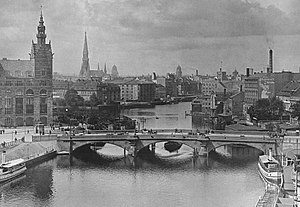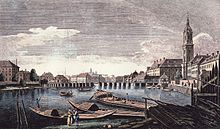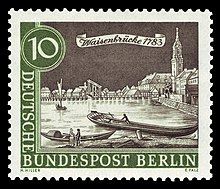Orphan Bridge
Coordinates: 52 ° 30 ′ 53 ″ N , 13 ° 24 ′ 55 ″ E
| Orphan Bridge | ||
|---|---|---|
| Orphan Bridge 1904 | ||
| use | Road traffic | |
| Convicted | Street train Am Köllnischen Park - Neue Friedrichstrasse (since 1951 Littenstrasse) | |
| Subjugated | Spree | |
| place | Berlin center | |
| construction | three-span stone arch bridge | |
| overall length | 77.0 m | |
| width | 20.4 m | |
| Longest span | about 25 m | |
| Clear height | 4.5 | |
| start of building | 1892 | |
| completion | 1894 | |
| closure | January 25, 1960 | |
| location | ||
|
|
||
|
Canceled in 1960/61 |
||
The Waisenbrücke was a stone bridge clad with red sandstone in the Mitte district of Berlin . It connected Littenstrasse , north of the Spree , until 1951, Neue Friedrichstrasse, with Märkischer Platz, south of the Spree , from which Wallstrasse and Am Köllnischer Park lead away. After the demolition in 1945 before the invasion of the Red Army, the bridge was makeshift repaired. The structure was dismantled in 1960 when there were other functional Spree crossings in the vicinity. Stone abutments still visible on both sides are a reminder of the building. The bridge was east of the Mühlendamm lock .
history
First wooden Spree crossing at this point
Originally there was the Oberbaum at the place of the orphan bridge , with which the passage for ships was blocked at night. A wooden yoke bridge with five pairs of flaps was built next to the Oberbaum in 1703 for the ship's passage. At first it was called the bridge to Neu Cölln , later called the Blocks Bridge. This was of great importance for the city in the 18th century, not least due to its generous dimensions of 83 meters in length and 6.90 meters in width. The bridge was named Waisenhausbrücke or Waisenbrücke in 1770 after the " Great Friedrich Hospital " built nearby at the end of the 17th century , which also served as a nursing home for orphans and was demolished in 1908. Compare with Waisenstraße, which is parallel to Littenstraße. In 1832 the bridge was renewed as a wooden bridge.
A stone jewelry bridge was built at the end of the 19th century
After almost 200 years of use and the expansion of Berlin as a royal residence, the Berlin magistrate had government builder Wilhelm Brancke build a stone bridge to replace it at the same location from 1892–1894. Stone bridges were generally considered to be more stable and less prone to repair, they could also be built without flaps and with larger spans. The new orphan bridge was clad with red sandstone slabs from the Main area . The structure was given balconies above the column-like ornamentation of the two central pillar heads. The visible surfaces were decorated with reliefs and coats of arms and the railing was designed as a baluster . Eight wrought-iron multi-armed gas candelabra provided light for the bridge users at night. The bridge had a width of 21.5 m with a length of 91 meters.
After being destroyed in the war, an emergency bridge is built

Towards the end of the Battle of Berlin in April 1945, the southern vault of the bridge was blown up by Wehrmacht troops . An emergency bridge, a provisional wooden structure only 5.5 m wide, erected soon afterwards, led traffic over the Spree because the reconstruction of the neighboring Jannowitz Bridge and the Mühlendamm Bridge could not be carried out so quickly. The rubble railway used to clear the destroyed city center was carried over this temporary bridge from 1949 to 1954.
demolition
With the completion of the new Jannowitz Bridge, the end of the transport of rubble and in accordance with the demands of shipping, the city administration had the Waisenbrücke demolished in 1960.
The two landside former connections for the bridge have been preserved, on the south side the rest serves as a ship landing stage, on the north side on the Rolandufer in continuation of a small green area, benches for strollers are set up.
Possible reconstruction
In the “Twelfth Ordinance on the Formal Definition of Redevelopment Areas” of March 15, 2011, the “missing orphan bridge” was described as a weakness for northern Luisenstadt and its reconstruction was defined as a key project with lower priority. The long-term reconstruction as a pedestrian and cycle path connection should cost around 3 million euros. The Märkisches Museum also campaigned for the reconstruction of the neighboring orphan bridge and dedicated several events to this topic in 2016. For the Berlin Senate, according to a statement in April 2017, reconstruction “has no priority and is therefore without a namable realization perspective .” In October 2018, the Senate Department for Urban Development and Housing published a step-by-step plan for Berlin mid-2018-2030 , in which the construction of the bridge in the 2026 time window –2030 is taken into account.
Neighboring objects
In the 19th century there were on the banks of the Spree next to the Waisenbrücke:
- the sugar factory Splittgerber,
- the orphanage with the orphan church,
- large warehouses,
- a slaughterhouse,
- a river bathing establishment (from 1894).
For the 2010s, the following buildings and squares are worth mentioning
- on the north side
- the Schicklerhaus
- the Berlin State Mint
- on the south side
- the naval house
- the Köllnische Park
- the Märkisches Museum .
Orphan Bridge in Art and the Media
The artist Johann Georg Rosenberg made a colored copper engraving of the wooden valve bridge in 1780 . The Deutsche Bundespost Berlin used this old engraving as a template for a 10-pfennig stamp as part of a series of city views of Berlin around 1780 . The new stone arch bridge was the subject of a drypoint etching by Ulrich Hübner (1872–1932) that was sold in a private auction house around 2006.
Ulrich Becher's novella Highly musical old lady , published in “ Die Zeit ” in October 1958 , uses a rented apartment building on the Waisenbrücke around 1907 as the main location.
In an elaborately designed album from Berlin, its western suburbs and Potsdam. According to the table of contents, there are also photos of the Orphan Bridge, three large panoramas and 129 views based on snapshots in photo print.
A poem circulating in Berlin vernacular takes the crimes that occurred in the poorly lit city as a motive for a bumpy rhyme in connection with this bridge:
Once Mr. Mücke and Mrs. Mücke crossed the orphan bridge.
Then a mosquito stung Frau Mücke in the neck.
Then Herr Mücke took his crutch and hit the mosquito in the neck.
That was the murder on the Orphan Bridge.
literature
- Frank Eberhardt: Disappeared from the cityscape: the orphan bridge . In: Berlin monthly magazine ( Luisenstädtischer Bildungsverein ) . Issue 2, 1999, ISSN 0944-5560 , p. 58-63 ( luise-berlin.de ).
- Kathrin Chod, Herbert Schwenk, Hainer Weisspflug: Orphan Bridge . In: Hans-Jürgen Mende , Kurt Wernicke (ed.): Berliner Bezirkslexikon, Mitte . Luisenstadt educational association . tape 2 : N to Z . Haude and Spener / Edition Luisenstadt, Berlin 2003, ISBN 3-89542-111-1 ( luise-berlin.de - as of October 7, 2009).
- Eckhard Thiemann, Dieter Desczyk, Horstpeter Metzing: Berlin and its bridges . Jaron, 2003, ISBN 3-89773-073-1 , pp. 177/178 .
- F. Krause, F. Hedde: The bridge construction of the city of Berlin since the year 1897. In: Zeitschrift für Bauwesen. Edition 72. 1922, issue 1–3, p. 13 ff. ( Digital.zlb.de ).
Web links
- Photo by Heinrich Zille: "View from the Waisenbrücke to the west"; Year 1900 , license in the public domain
- Painting of the orphan bridge with debris loading point 1952 ; Archive of the German Photo Library
Individual evidence
- ↑ The morning. January 26, 1960.
- ↑ (official) city map of Berlin ( memento of the original from November 16, 2016 in the Internet Archive ) Info: The archive link was inserted automatically and has not yet been checked. Please check the original and archive link according to the instructions and then remove this notice. , Sheet 4231 from 1940, X = 27530, Y = 20870.
- ↑ (official) city map of Berlin ( memento of the original from November 16, 2016 in the Internet Archive ) Info: The archive link was inserted automatically and has not yet been checked. Please check the original and archive link according to the instructions and then remove this notice. , Sheet 4231 from 1961, X = 27530, Y = 20870.
- ↑ Picture from 1894: Landesarchiv Berlin, Hermann Rückwardt: Waisenbrücke in the course of the Neue Friedrichstrasse over the Spree, from "An der Stralauer Brücke" to the Brandenburg embankment.
- ↑ Picture from 1901: Landesarchiv Berlin: Waldemar Titzenthaler: Waisenbrücke from the street “An der Stralauer Brücke” to the street “Neukölln am Wasser”.
- ↑ Photo 1907: Landesarchiv Berlin, Waldemar Titzenthaler: Waisenbrücke. Left: Märkisches Museum under construction. In the foreground: river bathing establishment.
- ^ Angela M. Arnold, Gabriele von Griesheim: Trümmer, Bahnen und Bezirke, Berlin 1945 to 1955 . Self-published 1999, p. 143 ff
- ↑ cf. between city map Berlin 1955 and city map Berlin 1961
- ↑ Twelfth ordinance on the formal definition of redevelopment areas of March 15, 2011.
- ^ Märkisches Museum: Summer Academy: The new orphan bridge. ( Memento of the original from March 13, 2017 in the Internet Archive ) Info: The archive link was automatically inserted and not yet checked. Please check the original and archive link according to the instructions and then remove this notice. July 14, 2016
- ↑ Berlin House of Representatives, Written question and answer “Reconstruction of the Waisenbrücke” from March 27 and April 6, 2017.
- ↑ Senate Department for Urban Development and Housing, Section II A HÖ: Step-by- step plan Berlin Central 2018 - 2030. In: Senate Department for Urban Development and Housing of the State of Berlin. October 1, 2018, accessed June 24, 2019 .
- ↑ Kiezinfo Brunnenstrasse
- ↑ Former river bathing establishment “Behind the Werderschen Mühlen at the city lock ” , first moved to the Schloss Freiheit, then to the Waisenbrücke
- ↑ Waisenbrücke FIS-Broker (map of Berlin 1: 5000 (K5 color edition)) of the Senate Department for Urban Development and Environment Berlin
- ^ Satow auction house , accessed on April 13, 2009
- ↑ Highly musical old lady . In: Die Zeit , No. 40/1958
- ^ Album from Berlin, its western suburbs and Potsdam. 3 large panoramas and 129 views based on snapshots in photo print , 1903, Berlin, Globus Verlag Berlin.






